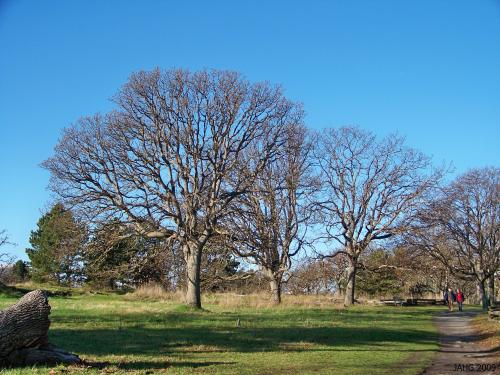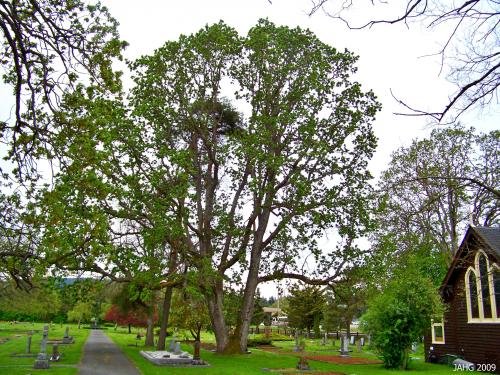One of the most noticeable things about southern Vancouver Island is how dry it is for long periods of the year. We often have little or no rain from late May through until the end of September. This is a very tough situation for most plants to endure if they are not adapted to it. I have seen many shrubs and trees scorch from the heat combined with lack of sufficient water. Luckily for us many native plants here are unusually attractive and grow well in the stony ground on the island. One tree which is endemic here is the Garry Oak (Quercus garryana) which stands out at this time of the year. it is also known as the Oregon Oak or Oregon White Oak.
There are 3 varieties of Garry Oaks which live in Western North America. Quercus garryana var. garryana is found here and lives in the largest area which ranges from Southern California, along the coastal mountain ranges up to southern Vancouver Island and the gulf Islands. The variety var. breweri is found in the Siskiyou mountains in Oregon with the final variety var. semota found in the Sierra Nevada area. This Oak was named by David Douglas to honor Nicholas Garry who helped him in his collection of plant samples in the Oregon area. Nicholas Garry(1782?-1856) was employed by Hudson’s Bay Company and later rose up to be the Deputy Governor of the company. Garrya elliptica is also named after him.
Garry Oaks are the only Oaks found in Western Canada and they are part of an endangered ecosystem which is in a very small area of southern British Columbia. Garry Oaks are very representative of the 116 species of plants, animals and insects which are found here and no where else in the world. This delicate ecosystem is under attack mainly from expansion of human settlement and introduction of invasive and destructive species from other places. large areas have been altered and changed and it is just recently that we have started to protect some of these remaining sites.

Sea Blush, Common Camas and Shooting Stars are but a few of the species growing amongst the Garry Oaks.
Garry Oaks have never really been important to the survival of native groups here. They made combs and digging utensils with the wood or used it for fueling fires. The acorns were eaten but were not considered a choice food, but could be roasted or steamed and eaten. Garry oak was known to be used medicinally for a treatment for tuberculosis and used as a drink for women before child birth.

The thick ridged bark protects the tree from fires which were used in creating Camas fields that native peoples farmed.
Quercus garryana generally have broad spreading rounded crowns which are made up of thick ascending crooked branches. These trees grow to 40-90ft (12-28m) tall and nearly as wide. In areas where there are other competing plants these trees will often grow tall and gawky but in an open meadow their true form is seen. Young trees to around 25 years of age often look scrubby and will often be seen growing in groups.

These Garry Oak are found in Playfair Park and in the spring a sheet of blue Camas bloom underneath them.
Garry Oak are slow growing trees which will grow 8-12(20-30cm) in a year. They develop long tap roots and are amost impossible to transplant after they have been in the ground a few years. They need a sunny open site with very well drained soil. They do not make good lawn trees as they resent being watered during the summer and it can also cause them to become diseased. They do have natural insect pests which are often seen on the undersides of the leaves. These can become disfiguring to the leaves some years but in others are hardy present at all. If you have the right site and would like a tree which needs little attention during the year, you might want to look into to this species or one of the other Oaks. Garry Oak grow in zones 6 through 10 (-10 f or and higher temperature).
Learn more about Garry Oaks:
Garry Oak Ecosystem: http://www.goert.ca/
Where is Holy Trinity Church: http://www.waymarking.com/waymarks/WM65KB_Holy_Trinity_Church__North_Saanich_BC_Canada
wiki on Garry Oaks: http://en.wikipedia.org/wiki/Quercus_garryana




























 Stumble It!
Stumble It!






